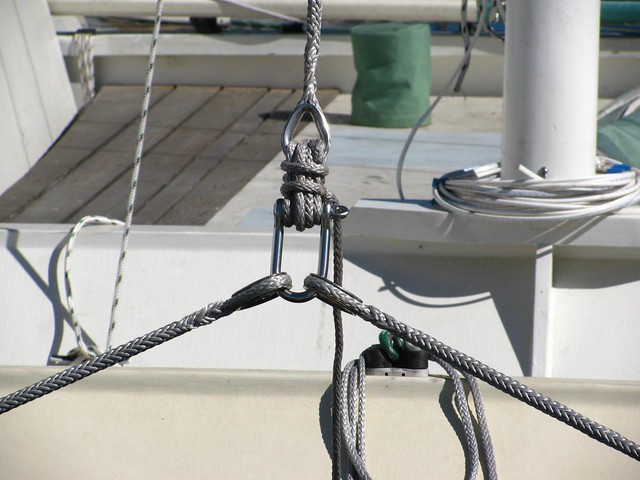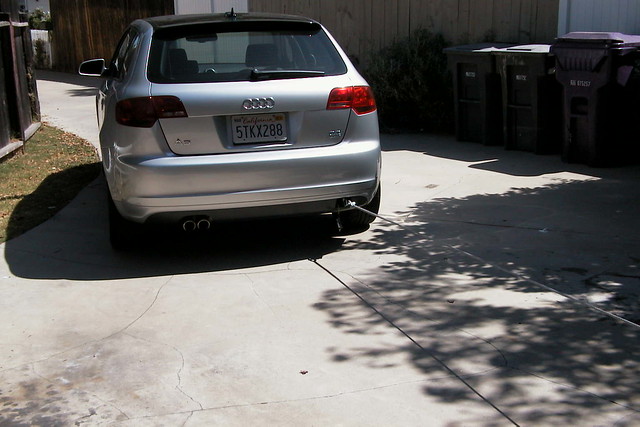A Photo & Discussion Forum for Wharram Design Enthusiasts
Greetings to all from down-under,
I would really appreciate comments on the following.
I am thinking of using 7mm Dynex Dux rope for my cap, intermediate shrouds and backstay on my Pahi 42 instead of the traditional wire rope. Dynex Dux is 40% stronger, 70% lighter, easier on the hands and doesn't rust. The projected life of braided Dux is 7- 10 years.
I am also thinking of attaching the mast shrouds to the crossbeams rather than the hulls, based on the fact the the beams move much less than the hulls and so would reduce the stress loads on the shrouds/mast.
Any thoughts/input on the above would really be appreciated.
John & Kat
I would really appreciate comments on the following.
I am thinking of using 7mm Dynex Dux rope for my cap, intermediate shrouds and backstay on my Pahi 42 instead of the traditional wire rope. Dynex Dux is 40% stronger, 70% lighter, easier on the hands and doesn't rust. The projected life of braided Dux is 7- 10 years.
I am also thinking of attaching the mast shrouds to the crossbeams rather than the hulls, based on the fact the the beams move much less than the hulls and so would reduce the stress loads on the shrouds/mast.
Any thoughts/input on the above would really be appreciated.
John & Kat
Views: 831
Replies to This Discussion
-
I have played around with the Dux recently. Amazing stuff. Easy to work, takes a splice in seconds, no burrs or other hand issues. I am using the Dux line, the 5mm as the only point of attachment of the ama's on my small (25foot) trimaran. These are simple Dux line loops spliced in place. The ama's beams slide through these loops and then are fixed into place with a pin (this is a trailer boat). No problems whatsoever with the Dux. No stretch at all.
You will need a really really good ceramic knife and a sharpening tool for same. Plus some very wide grip pliers for pulling on the line as it is rigged or repaired.
Oh, by the way, you can carry a full set of replacement shrouds in a small sack with this stuff.
I am learning to make my own soft shackles, and even have made a running block with the line and a simple wood spool when i needed to assist in recovery of a fellows' swamped 20 foot fishing boat. I made a couple of blocks, rigged a line through the top of the mast and then voila, just hoisted his boat right out of water.
cool stuff. Going to play with it some more. Lots of interesting uses about the house and boat.
clif
-
Hi Jon, Kat, and Cliff,
This isn't something we'll have to decide on for quite some time, however, the thought of the weight savings and the ability to carry a complete set of replacement shrouds makes this very attractive. We would love to hear more from anyone actually using Dux on a cruising vessel.
Thanks, Bob
-
hi Cliff, i reply here to another post because discussion is close about Pahi 42' in Samoa, may be you have some information ? my email kapalwest@yahoo.fr, ty
@lain
clif high said:I have played around with the Dux recently. Amazing stuff. Easy to work, takes a splice in seconds, no burrs or other hand issues. I am using the Dux line, the 5mm as the only point of attachment of the ama's on my small (25foot) trimaran. These are simple Dux line loops spliced in place. The ama's beams slide through these loops and then are fixed into place with a pin (this is a trailer boat). No problems whatsoever with the Dux. No stretch at all.
You will need a really really good ceramic knife and a sharpening tool for same. Plus some very wide grip pliers for pulling on the line as it is rigged or repaired.
Oh, by the way, you can carry a full set of replacement shrouds in a small sack with this stuff.
I am learning to make my own soft shackles, and even have made a running block with the line and a simple wood spool when i needed to assist in recovery of a fellows' swamped 20 foot fishing boat. I made a couple of blocks, rigged a line through the top of the mast and then voila, just hoisted his boat right out of water.
cool stuff. Going to play with it some more. Lots of interesting uses about the house and boat.
clif
-
Cliff, I would love to get some info on splicing Dux. I have about 25 splices to do around s/s eye thimbles & most I've found look very tricky, slow and labour intensive. I was tempted to just tie a really good knot!!
Cheers,
John & Kat
-
John, look at the lower right side of Colligo's web site: Colligo . Very good info on splicing high modulus line. They do need to be properly done, of course, but splicing 12-strand hollow braid is much easier than splicing double-braid line, ie, Sta-set. You do need to do some practice splices in order to understand how much the line's 12-strand construction will lengthen as it resets under load. I am not talking creep here, just the constructional stretch.
This shows the bridle/forestay on my tiki 26, Vaea, before sailing. After sailing, I am just about ready to simply join the bridle/forestay using a shorter forged Wichard shackle.

Here is my shroud tensioning setup:

I should have done the forestay for a bit longer. I hooked the line to the tow hook on my car, with the other end stropped to the base of a telephone pole!
I did not use Dynex Dux, but simply Samson's Amsteel Gray. I do have a length of Dux in my shop, enough to do a bridle/forestay, due to paranoia about creep (permanent elongation due to constant load), but I don't think the tiki 26 will need it. A high-tension rig, ie, a bermuda rig with spreaders, diamond stays, would be a candidate for Dux. You need to calculate the rigging loads as designed, and then size the synthetic line to avoid creep. If the line is sized to take 20% of its breaking load, it will not creep.
BTW, the Dynex Dux is much stiffer stuff than the non-heat treated line. I would not look forward to making locking Brummels with it! The 9mm Dux in my shop is as stiff as wire.
-
Kim, I always like to see folks respecting the important work of shackles. We learned the hard way not to use budget shackles on Peace IV. If it is super important structurally or if it is aloft, it is Wichard for us. They cost the earth, but they do not break. We used to think that getting a larger size budget shackle would keep us safe but have seen them break across defects in their construction including bubbles, microscopic cracks, etc. It could cost you your life... so get the good stuff! Ann and Nev
-
Splicing is simple. The Dux line has rigor mortis, absolutely feels stiff as a long dead stick...UNTIL you take a length between your hands and push back against the weave. Then the length between your fingers goes instantly soft. As it is a 12 strand line, the simple hollow fid available from on line merchants all over will make it a snap to do even tricky splices such as around metallic and plastic items. With dux the splices can be actually measured down to the mm and since there is no stretch under load, what is hanked hard to a brace stays that way. Lots of online references to hollow fid splicing. Easy as pie. Even easier as a matter of fact.
clif
-
Kim, Cliff, Ann & Nev,
Thank you very much for your advice. My first mate (Kat) will give the splicing a go, and I'll start looking for Wichard shackles (or their equivalent) in Australia.
Does anyone have any thoughts on attaching the cap and intermediate shrouds to the crossbeams. It seems to me that the beams move much less than the hulls, and so approximate the setup on a monohull. I have made my crossbeams 30% stronger than the standard, so they are well able to take the load. It seems to me that the hull lashings pull down on the beam, and the shroud lashings pull up, thereby equalising each other to a degree. Or am I oversimplifying it?
Cheers,
John & Kat
© 2025 Created by Budget Boater.
Powered by
![]()